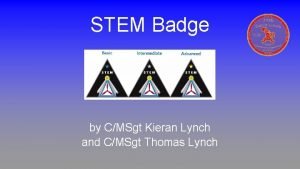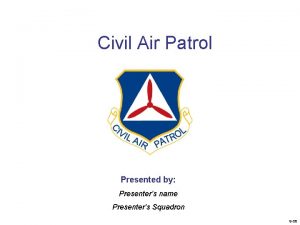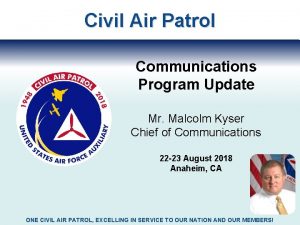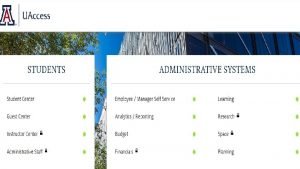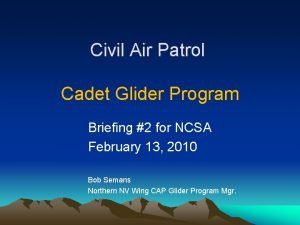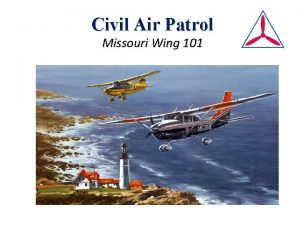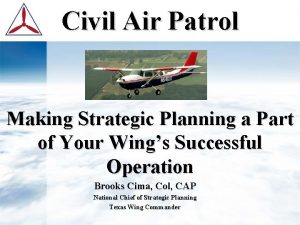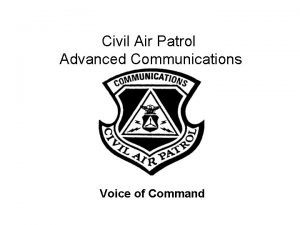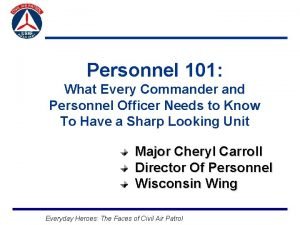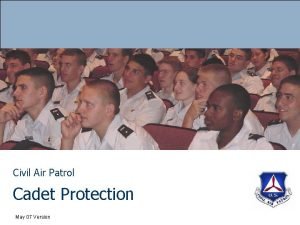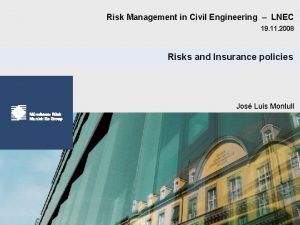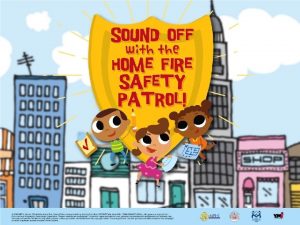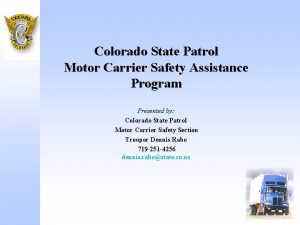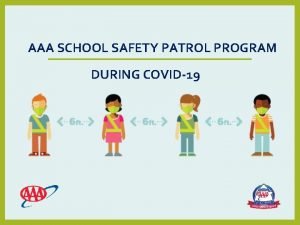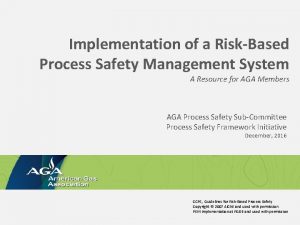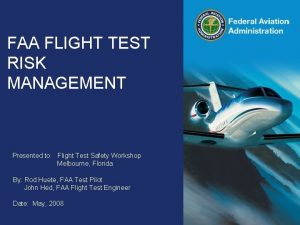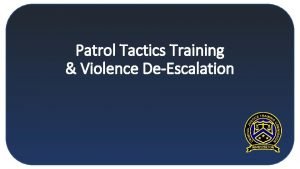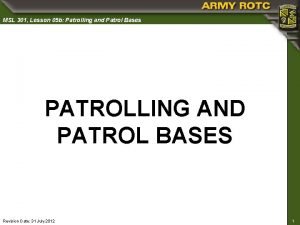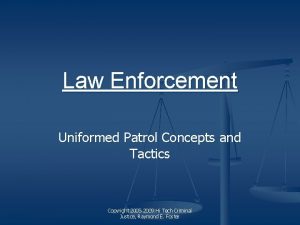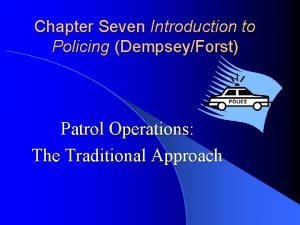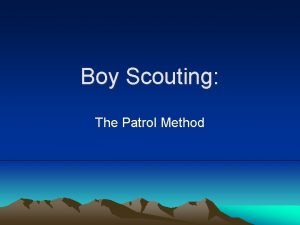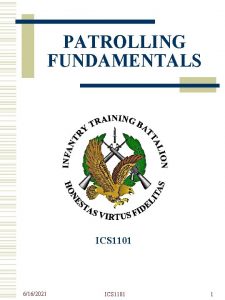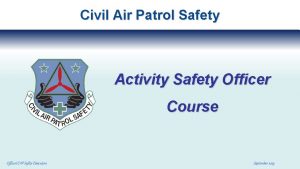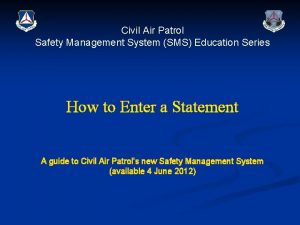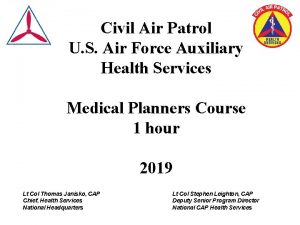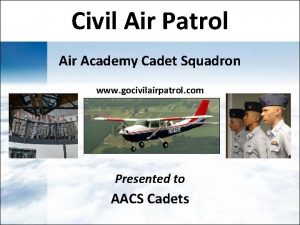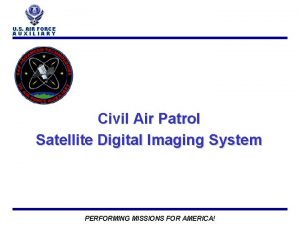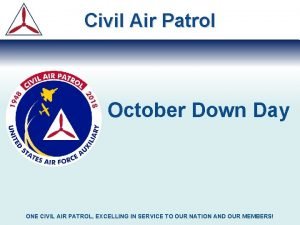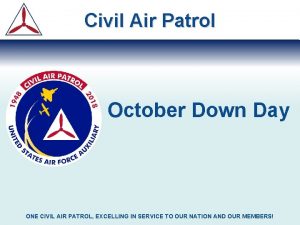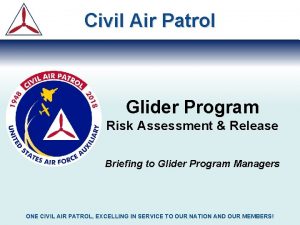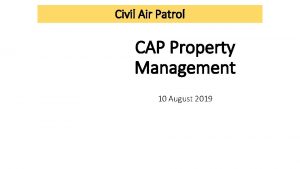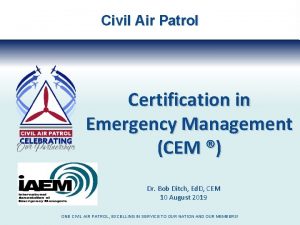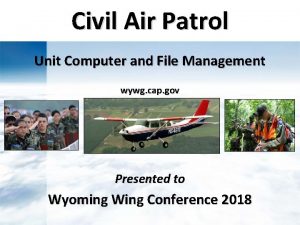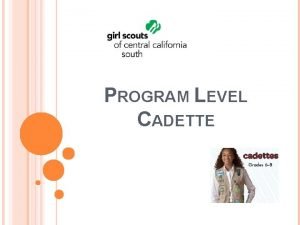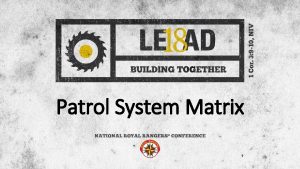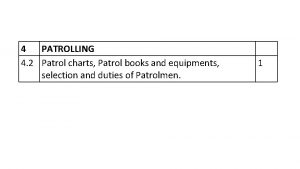Civil Air Patrol Safety Annual Safety Risk Management




































- Slides: 36

Civil Air Patrol Safety Annual Safety Risk Management Day 2020 Official CAP Safety Education

Today’s Plan Includes… • Conducting a Risk Assessment • • • A quick review of Risk Management and CAPR 160 -1 Become familiar with the CAPF 160, Risk Assessment Worksheet Group exercise on using the CAPF 160 • Common Mishaps • • Review common CAP mishaps and their causes and contributing factors Discuss what you personally, and as a group, can do to address those factors • Region/Wing/Unit Emphasis Items • Open Discussion! Official CAP Safety Education

Civil Air Patrol Safety Conducting a Risk Assessment Official CAP Safety Education

Personal Culture of Risk Management • “The goal of the CAP Safety Program is for each and every member of Civil Air Patrol, as well as the organization itself, to embrace and practice RM as a core competency of Civil Air Patrol. ” (CAPR 160 -1, paragraph 1. 2. 4. ) • “ … the diverse and localized aspects of CAP operations and activities demand that individuals and groups fully understand routinely apply safety RM processes as a matter of habit. ” (CAPR 160 -1, paragraph 1. 5. 4. ) Every CAP member is expected to use risk management practices “as a matter of habit” when engaged in any CAP activity. All activities come with hazards and risks … Official CAP Safety Education individuals and groups must be committed to the same risk management processes.

Levels of Risk Management • Deliberate Risk Management • • • Full formal application of the RM steps Use the CAPF 160, Deliberate Risk Assessment Worksheet Used for large activities (e. g. , NCSAs, Encampments, Flight Academies, etc. ) (see CAPR 160 -1 for guidance) • Real Time Risk Management • • • Smaller events and activities Reduced planning time, but same RM process Use the CAPF 160 S, Real Time Risk Assessment Worksheet (see CAPR 160 -1 for guidance) Official CAP Safety Education

Risk Management Principles 1. Accept no unnecessary risk • • Reduce risk As Low As Reasonably Possible (ALARP) Then determine if the risk is low enough to allow your mission or activity 2. Make Risk Decisions at the appropriate level • • The person in charge of the event usually determines if risk is acceptable Remember … Only CAP/CC can approve if risk is “High” or “Extremely High” 3. Integrate RM into ALL missions and activities • RM must be used in the planning and the execution of ALL CAP activities 4. Apply RM continuously … before, during, and after Official CAP Safety Education (See CAPR 160 -1 for more information)

Risk Management Review • Five Step Process • • • Identify - what can hurt you? Assess - how likely, and how badly? Controls - how can you prevent it? Implement - build controls into plan Evaluate - how well is plan working? • The Loop! • • • Official CAP Safety Education It’s a continuous process Look for new/different hazards and risks Adjust your risk controls

Official CAP Safety Education

Identify Hazards • Every activity is made up of numerous smaller activities • • Look for hazards associated with the main activity Examine each sub-activity for hazards • Use blocks 4 and 5 of the CAPF 160 to list sub-activities and their hazards • Look for hazards in all of the “ 5 Ms” • • Unclear Guidance? Weather? Facilities? Member? Equipment? Tasks? Mission Intensity? See “Using the Five M’s” guide on Risk Assessment webpage Official CAP Safety Education

Identify Hazards (continued) • Gather your team • • • Questions for each activity or task: • • What can go wrong? What can break? How could someone get hurt? “What if …” • • Brainstorm to think of all the hazards What risk do they bring? Ask “what if” something went wrong with each part of the plan Have you done anything like this before? • What worked (and what didn’t) the last time you did this? Official CAP Safety Education

Assess the Risk • If a hazard can cause an injury, the risk level is determined based on: • The probability of the injury happening, and • The severity of the injury if it occurs • Probability + Severity = Risk Level • Use the Risk Matrix on page 3 of CAPF 160 to determine the risk level for each hazard Official CAP Safety Education

Assess the Risk • For each hazard, use the definitions in the matrix to … - Estimate the Probability of damage or injury occurring - Estimate the Severity of the damage or injury if it occurs • Read across, and vertically, to see the level of risk (EH, H, M, or L) • Be honest with your estimates • Use worst-case scenario • Discuss with your team Official CAP Safety Education

Develop the Risk Controls Reduce the probability Reduce the severity Ask yourself what is causing each risk … target your risk controls at that cause A Few Options: • • Eliminate the risk: Is that event or that piece of equipment really needed? Reduce exposure to the hazard: Reduce your time in the sun? Reduce the number of people allowed on the flight line? • Train people: …how to avoid the hazard. …how to perform the task correctly • Warn people: Brief them … Put up signs … Rope off danger areas … Supervise • Prepare your members: Proper rest, nutrition, hydration, wingman, training • Improve the design: Make it more efficient. Don’t try to do “too much. ” • Supervise: Assign spotters. Observe changing conditions. Call “knock it off” Official CAP Safety Education

Develop the Risk Controls For each hazard you listed … • Use Blocks 7 & 8 on the CAPF 160 to enter the risk control you selected • You may have more than one control for each hazard • Describe HOW you will implement each control and how you will monitor it • Enter the name of the person responsible for making sure the Official CAP Safety Education control

Develop Risk Controls Prioritizing Your Risk Controls • Prioritize the Risks • Focus first on the hazards that bring the highest levels of risk • Try to completely eliminate that hazards that bring H or EH risk levels • Prioritize the Risk Controls • There may be numerous ways of controlling each risk • Focus on the risk controls that have … • … the most benefit (the most effective at reducing risk) … • … balanced with the cost, effort, and available resources Official CAP Safety Education

Assess the Residual Risk • With your risk controls in place (and working), each risk should be reduced • That reduced risk is the “Residual Risk” • Use the Risk Matrix again to determine the Residual Risk with your risk controls in place • Record the residual risk for each hazard using the dropdown menus in Block 9 of the CAPF 160 NOTE: Refer to CAPR 160 -1 for approval authority if ANY risk is High (H) or Extremely High (EH) Official CAP Safety Education

The RM “Loop” One of the most important components of Risk Management is the Loop, signifying that RM must be a continuous process! • Supervise and Evaluate • • • Everyone must watch for new hazards, new risks, or controls that aren’t effective Risk Controls can (and should) be updated and improved Consider a “knock it off” if big changes are needed or new risks arise • After Action and Lessons Learned • • • Gather your team Discuss what controls worked and which didn’t Document your “lessons learned” using Block 14 of CAPF 160 - you’ll want to refer back to it next time you have an activity like this! Official CAP Safety Education

Getting Started • Congratulations! You’ve just been assigned to do a risk assessment (RA) for an event at your squadron! Official CAP Safety Education

Cadet Squadrons • Cadet Squadrons – Complete a Risk Assessment using the CAPF 160 covering the first day of a squadron overnight event. From drop off at the squadron to lights out the first night. • Examples may include: • Early/Late Arrival to squadron • Forgotten Items • Hot/Cold climate • What other issues or hazards might you experience? Official CAP Safety Education

Cadet Squadrons Member Arrives early to squadron Young member waiting alone could be injured, or kidnapped H Fill in your activity and describe the hazard, then assign it a Risk Level Official CAP Safety Education Brainstorm as a group to think of additional

Cadet Squadrons • Controlling the hazards • What can be done to prevent the hazards you identified? • Example: Hazard - Forgotten Items • Control measure - Create a checklist for the activity, each cadet will then review the checklist with a senior member prior to departing from the squadron enroute to the activity location to make sure all required items are packed. • How would you control the other issues you identified? Official CAP Safety Education

Cadet Squadrons Member Arrives early to squadron Young member waiting alone could be injured, or kidnapped H A welcome team will be created to meet cadets when they arrive at the squadron. A welcome team will be at the squadron 30 minutes prior to expected cadet arrival time. Now enter your risk control and how you will implement the new control Official CAP Safety Education

Cadet Squadrons • Who is going to be the person responsible to make sure the control measures you picked are completed? • Assign a member or a team to each control measure Official CAP Safety Education

Cadet Squadrons Member Arrives early to squadron Official CAP Safety Education Young member waiting alone could be injured, or kidnapped H A welcome team will be created to meet cadets when they arrive at the squadron. A welcome team will be at the squadron 30 minutes prior to expected cadet arrival time. Capt Jones & Welcome Team.

Cadet Squadrons • Next you need to make sure that your control has reduced the hazard level to an acceptable new level • If your control does not reduce the level, you may need to change or update your controls • Always review your controls after the event to see if it worked, or if it needs to be changed based on what you learned Official CAP Safety Education

Cadet Squadrons Member Arrives early to squadron Official CAP Safety Education Young member waiting alone could be injured, or kidnapped H A welcome team will be created to meet cadets when they arrive at the squadron. A welcome team will be at the squadron 30 minutes prior to expected cadet arrival time. Welcome Team. L

Congratulations! You have started your Risk Assessment for your overnight squadron event! Official CAP Safety Education

Senior Member Squadrons • Senior Member Squadrons - Complete a Risk Assessment using the CAPF 160 on the process of Spring Cleaning in your facility. • Examples may include: • Moving Aircraft • Dangerous Insects • Use of chemical cleaners • What other issues or hazards might you experience? Official CAP Safety Education

Senior Member Squadrons Cleaning Floor Mixing ammonia and bleach can create a toxic gas H Fill in your activity and describe the hazard, then assign it a Risk Level Official CAP Safety Education Brainstorm as a group to think of additional

Senior Member Squadrons • Controlling the hazards • What can be done to prevent the hazards you identified? • Example: Hazard – Cleaning the floors • Control measure – Due to the potential for a toxic gas to develop from the use of ammonia and bleach, only natural cleaners will be purchased and used in the cleaning process • How would you control the other issues you identified? Official CAP Safety Education

Senior Member Squadrons Cleaning Floor Mixing ammonia and bleach can create a toxic gas H Use of ammonia will be prohibited for cleaning purposes Only natural cleaning products will be purchased and used for cleaning Now enter your risk control and how you will implement the new control Official CAP Safety Education

Senior Member Squadrons • Who is going to be the person responsible to make sure the control measures you picked are completed? • Assign a member or a team to each control measure Official CAP Safety Education

Senior Member Squadrons Cleaning Floor Official CAP Safety Education Mixing ammonia and bleach can create a toxic gas H Use of ammonia will be prohibited for cleaning purposes Only natural cleaning products will be purchased and used for cleaning Capt Jones & Cleaning Team

Senior Member Squadrons • Next you need to make sure that your control has reduced the hazard level to an acceptable new level • If your control does not reduce the level, you may need to change or update your controls • Always review your controls after the event to see if they worked, or if they need to be changed based on what you learned Official CAP Safety Education

Senior Member Squadrons Cleaning Floor Official CAP Safety Education Mixing ammonia and bleach can create a toxic gas H Use of ammonia will be prohibited for cleaning purposes Only natural cleaning products will be purchased and used for cleaning Cleaning Team L

Congratulations! You have started your Risk Assessment for Spring Cleaning of your squadron! Official CAP Safety Education
 Cap stem badge
Cap stem badge Civil air patrol national conference
Civil air patrol national conference Malcolm kyser
Malcolm kyser Civil air patrol kahoot
Civil air patrol kahoot Civil air patrol ncsa
Civil air patrol ncsa Civil air patrol model rocketry badge
Civil air patrol model rocketry badge Civil air patrol aerospace module 1
Civil air patrol aerospace module 1 Civil air patrol missouri
Civil air patrol missouri Civil air patrol strategic plan
Civil air patrol strategic plan Civil air patrol frequencies
Civil air patrol frequencies Civil air patrol powerpoint template
Civil air patrol powerpoint template Cap blues uniform
Cap blues uniform Civil air patrol cppt
Civil air patrol cppt Market risk assessment
Market risk assessment Civil engineering risk management
Civil engineering risk management Pt tanah air sentosa
Pt tanah air sentosa Home fire safety patrol
Home fire safety patrol Motor carrier safety assistance program
Motor carrier safety assistance program Aaa school safety patrol badge
Aaa school safety patrol badge Civil rights webquest
Civil rights webquest Key risk indicators financial risk management
Key risk indicators financial risk management Risk map risk management
Risk map risk management Risk based process safety
Risk based process safety Safety risk management faa
Safety risk management faa Civil aviation safety authority
Civil aviation safety authority Ski apache web
Ski apache web Patrol tactics training
Patrol tactics training Patrol bases
Patrol bases Split-force patrol
Split-force patrol Highway patrol episode fake cop
Highway patrol episode fake cop Split force patrol
Split force patrol Scout method
Scout method Nissan patrol vibration problems
Nissan patrol vibration problems School crossing patrol winter coat
School crossing patrol winter coat Ics patrol
Ics patrol Nebraska state patrol concealed carry
Nebraska state patrol concealed carry Patrol totem
Patrol totem
